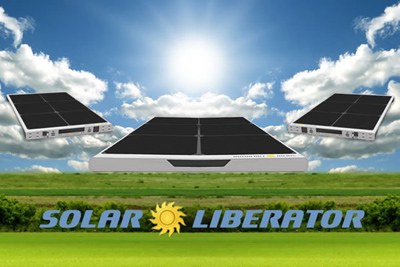January 4, 2014 – The Solar Liberator is a solar power appliance that combines photovoltaics, power inverter and lithium-ion battery. It comes in three sizes with the 500 Watt unit capable of being plugged in to a wall socket to feed power back to the grid.
The 500-Watt unit can be daisy-chained using supplied cables to create a large array of up to 4 units depending on your power requirements. Just use the supplied mounting kit to place it in a position where the sun can shine on it and let it do its thing. Then plug the array into a single household 15 Ampere power socket using the 9.1 meter (30 foot) A/C plug-in cord. Panels snap on to the mount. So no costly installation required.
The smaller 100 and 25-Watt units are not designed for grid tie-in but serve as portable power supplies that can be attached to a car, bicycle, backpack, tent, or portable heater to supply emergency power. Each comes with multiple AC sockets, USB ports and DC jack connectors.
All units have a built-in smart lithium-ion battery making the Solar Liberator usable day or night. The battery gives you 2 hours of power at full capacity or supplements solar power capacity on cloudy days. The embedded processor optimizes the system to make sure power is managed and distributed efficiently. And the accompanying Solar Liberator app lets you monitor its status from an iPhone, Android or Windows smartphone.
On Indiegogo, Solar Liberator has exceeded its fundraising target of $25,000 with a few days to go. You can still select a perk with a contribution taking advantage of discounts for pledges on the various units.
The company plans to sell the 500 Watt unit for $999.95 U.S., the 100 Watt for $299.95, and the 25 Watt at $129.95.
Solar Liberator comes with a 25-year warranty on the poly-crystalline photovoltaic cells. The units have a 5-year materials and workmanship warranty including the electronics. The company states the design lifespan of the electronics is 10 years or longer and the lithium-ion batteries come with a 1-year warranty and are rated to last 5 years using the software that optimizes charging cycles and thermal dissipation.






















There are two areas of code violation. The first violation is the line side physical disconnect with lock out capability. This can not be a breaker but a physical hard disconnect lever device which can be locked (with a lock) in open position required by the Utility or Fire department and fully supported by the NERC and NFPA.
The second violation related to Section 210 restricting to 12 amps through a breaker so that “utilization equipment or load” can not exceed the 12 amp current maxima of most household and business plugs. You can exceed this 12 amp limitation with better plugs, but unless its wired specifically with higher current plugs, you are risking overheating of the plug. Now in the case of a generator plugged directly into a socket.
Looking at the picture of the article it appears that there is a breaker on the side of the panel frame. I will assume for now that there is. Thus technically plugging this panel into a household circuit is safe. But keep in mind that all plugs are parallel wired. So if I plug one 500 watt panel in I have a maximum default current of 3 amps from the PV panel and 15 amps from the breaker box – a total of 18 amps. If I happen to plug four 500 watt panels into the same house or business circuit, aka, all panels are plugged into sockets on the same breaker circuit from the box, I have a maximum current output of 12 amps, but only register 3 amps on each PV panel 15 amp circuit breaker. The current node where the currents add together is on the branch not at the panels.
Thus I can supply 12 amps from the PV panels and 15 amps from the breaker box without ever “popping” a breaker because the current adds in parallel going to the load but no breaker ever sees greater than 15 amps. Thus an appliance could actually pull 27 amps through a 12 amp rated outlet without ever throwing a breaker. Note that at no time would the microinverters on the solar PV panels detect frequency or Voltage missing from the utility until the fire occurs.
The outlet will over heat, the wire to the appliance will overheat (since many fans use 16 or 14 AWG wire) and a fire could start.
Again, you could use this product as a power generator where the appliance or tool is plugged directly into the panel outlets. But you should never plug a power generator directly into a house or building outlet it does not matter if it is solar generator or a gasoline generator.
[…] Read the original: New solar power device makes installing home solar a breeze. […]
maybe you could do an update on this story about how the Solar Liberator group is almost a year past their delivery date, with no products to show, and serious doubts about the ability of the company to deliver what they promised. http://wp.josh.com/2014/01/07/not-another-fake-plug-in-grid-tie-solar-system/
I will contact the company to find out what has delayed them. It is not surprising that some of these technologies never make it past the gate.